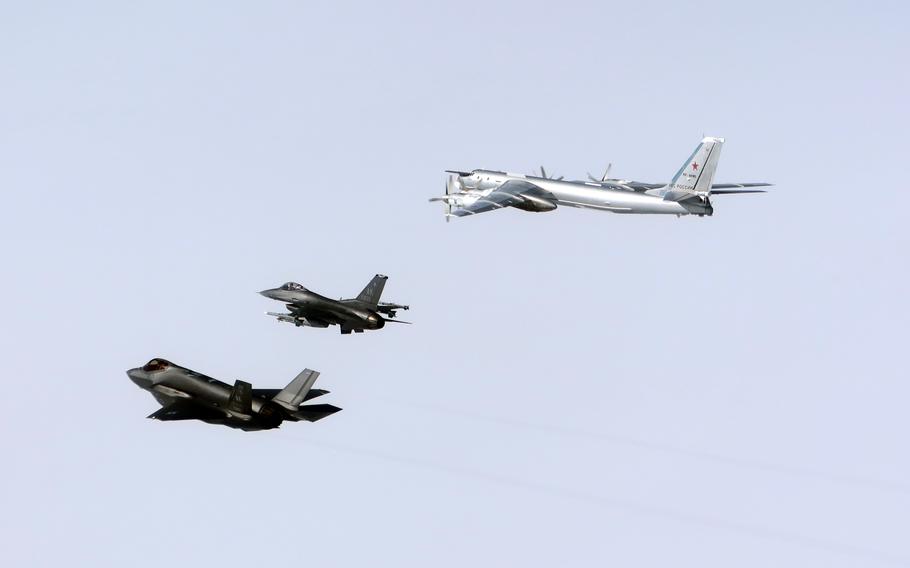Asia-Pacific
Russia says bombers completed 10-hour training flight between Japan and South Korea
Stars and Stripes July 31, 2024

Fighters with North American Aerospace Defense Command, or NORAD, intercept a Russian Tu-96 strategic bomber in the Alaska Air Defense Identification Zone, July 24, 2024. (NORAD)
CAMP HUMPHREYS, South Korea — Moscow sent a pair of missile-armed, long-range bombers on a 10-hour training flight this week between Japan and South Korea, according to the Russian Ministry of Defense.
The Tu-95MS Bear-H strategic bombers flew over international waters on Tuesday, according to a ministry statement that day. The report referred to the bomber mission as a “planned flight.”
South Korean and Japanese fighters intercepted the bombers en route, according to military sources in each country.
The Tu-95MS variant of the nuclear-capable, four-engine turboprop bomber is designed to carry cruise and stealth cruise missiles. It came into production in 1981.
Sukhoi Su-35S and Su-30SM fighters escorted the bombers, according to state-run Russian news agency Tass, which did not reveal the number of jets.
The bombers “at some stages of the route” were escorted by “foreign fighters,” according to the Defense Ministry.
South Korean jets “made sorties and the military took necessary measures” in response to the bomber presence, according to a statement Tuesday from the Joint Chiefs of Staff. A spokesman declined to provide details of the sorties.
The Japan Air Self-Defense Force also scrambled fighters to intercept the Russian aircraft, according to a news release Tuesday from the Japan Joint Chiefs of Staff.
The bombers appeared Tuesday morning from the west, flew eastward and turned north near the Oki Islands in western Japan, according to the release. They appeared again west of Hokkaido, the northernmost of Japan’s four main islands, then turned north and flew parallel to Japanese airspace before turning west again.
A Joint Staff spokesman would not say if the bombers and fighters were the same aircraft appearing at different occasions.
South Korean and Japanese government spokespeople typically speak to the media only on condition of anonymity.
The Russian aircraft kept strictly to international rules for using airspace, according to Russia’s Defense Ministry.
“Long-range aviation pilots regularly fly over the international waters of the Arctic, the North Atlantic, the Black and Baltic seas, and the Pacific Ocean,” the ministry said.
The Bears’ overflight of the Sea of Japan, also known as the East Sea, came a week after a pair of Tu-95s and a pair of Chinese Xian H-6K bombers flew inside the Alaska Air Defense Identification Zone and about 200 miles from the Alaskan coast.
The four-ship flight was intercepted by U.S. F-16 Fighting Falcons, U.S. F-35 Lightning IIs and Canadian CF-18 fighters from North American Air Defense Command, according to the Center for Strategic and International Studies.
That flight was the first of its kind by the two countries, which have joined in a “no limits” partnership, according to a Q&A published online by the center on Tuesday.
In December, two Russian and two Chinese bombers of the same type flew a joint operation over the Sea of Japan, joined by fighter jets from both countries for a total 17 aircraft, the Yomiuri Shimbun reported Dec. 15. The Japan Air Self-Defense Force scrambled fighters to intercept the flight, according to the report.